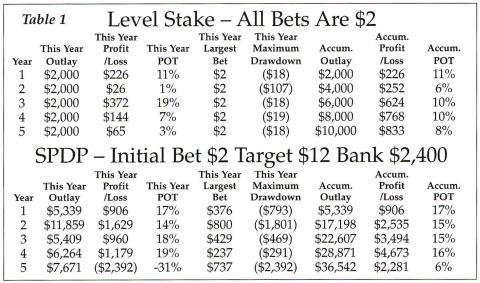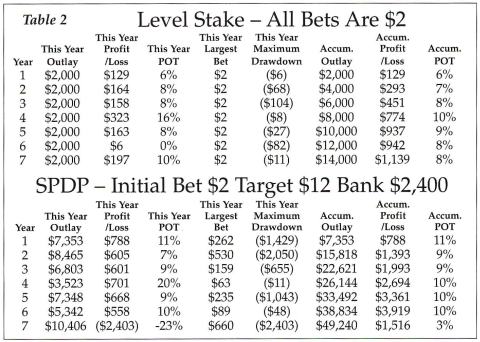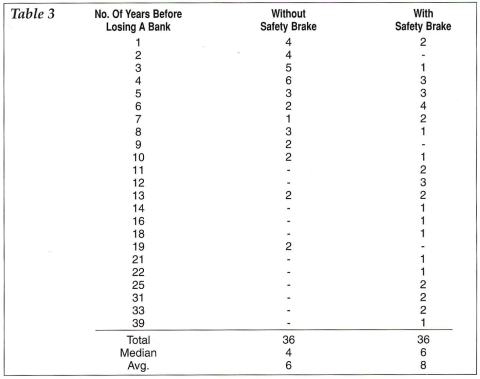Last month, 'Anomaly' Nick began his feature article on staking and the 'risk of ruin', in response to an article by Roman Koz in the February 1999 issue of PPM. He now concludes his argument.
- The "Betting A Percentage Of Bank" Staking Plan: Bet wagered is either the Initial Bet or the Specified Percent of Bank, whichever is the larger.
- The Six Point Divisor Plan (SPDP): Bet is Current Target divided by Current Divisor (start with a divisor of 6). If winning bet, then deduct Profit f rom Current Target and deduct winner's odds from Current Divisor. If Current Target is less than Initial Target, reset it to Initial Target.
But, for the purpose of this exercise, I will compare the Level Stake Plan with the SPDP.
THE RESULTS OF MY STAKING PLAN SIMULATIONS
Let's look at a situation where Perc the Punter has about 20 bets per week, an estimated level-stake profitability of 8%, average odds of 5/2, a bank of $2,400 and he uses a $2 starting bet. We will just compare the Level Stake Plan with the SPDP.
Simulation No. 1: Using the SPDP without a Safety Brake. I started off by doing a simulation for a year's betting (1000 bets) and determining the Profit/Loss. I then reset the bank to $2400 and repeated the exercise for another year of bets. I continued to do this until $2400 was lost during one of these simulations. I repeated this sequence of simulations 36 times.
This represented over 200 betting years of simulations; roughly 200,000 bets. The average number of years to lose a bank was six years and the median value was four years. Four times the loss happened in the very first year (this is a total bust!) and the longest time to lose the bank was 19 years.

Table 1 is an example of one of the 36 simulations where the $2400 starting bank was lost after five years. Note that at the end of Year 4 the SPDP had an overall POT of 16% (Profit $4673, Turnover $28,871) compared with the Level Stake POT of 10% (Profit $768, Turnover $8,000).
But in Year 5, when the SPDP's bank for that year ($2,392) was lost, this reduced the overall POT for the SPDP to 6%, whereas the Level Stake POT was reduced to 8%.
Remember that I reset the bank to its starting value after each year of bets.
I did this so as to be able to compare the POT of the two staking plans and demonstrate that they achieve about the same level of profitability in the long run but with one very important difference ... and this is that there is an ever existing possibility that the SPDP will go bust.
If I had not reset the bank back to its starting point at the beginning of each year and did simulations until the entire bank went bust, then there would be no grounds for comparison because when the SPDP finally goes bust its overall POT is minus 100%.
But the bottom line is that the SPDP has the same expected longterm POT as level-stake betting. And so I ask you this question:
IF YOU HAVE A SELECTION PLAN THAT GIVES YOU AN 8% POT YEAR IN, YEAR OUT, THEN WHY RISK GOING BUST BY USING A PROGRESSION STAKING PLAN?
If the lower profit of level-stake betting is a problem, then just increase your level-stake bet (in the above scenario, increase the bet from $2 up to $6 per bet) and you will have about the same profit. See Table 1 above.
Simulation No. 2: Using the SPDP with a Safety Brake.
In his article, Roman mentioned using a safety brake when you have three consecutive losers. This detracts from the SPDP being a true progression plan but it does improve one's chances of staying alive. I repeated the 36 simulations using a safety brake and this time the average number of years before a bank was lost was eight, with the median value being six years.
There was one simulation that took 39 years before a bank was lost but twice the SPDP went bust in its first year.

Table 2 gives an example of one of the 36 simulations where a bank was lost after seven years.

Table 3 shows a full summary of the SPDP bust stats (sounds a bit rude) both with and without the safety brake.
For example, the SPDP lost a bank six times in the fourth year without a safety brake operating but only three times in the fourth year with a safety brake operating.
CONCLUSIONS
To glibly use a progression staking plan without looking at your own betting profile spells DISASTER and will almost certainly lead you to blowing your entire bank. In particular, the SPDP is a very risky staking plan if the average price of your runners is above 9/4 or if you are having a very large number of bets.
Don't use a progression staking plan if your selections earn a levelstakes profit ... you can earn just as much money using a far less risky level-stakes betting plan by having bigger bets.
Do use a progression staking plan if your selections lose at level stakes as this is your only hope for a short-to-medium-term profit ... but expect to go broke, eventually. Click here to read Roman Koz's reply.
Click here to read Part 1.
By 'Anomaly' Nick
PRACTICAL PUNTING - MAY 1999